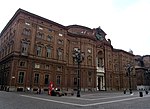Museo Egizio
1824 establishments in Italy1824 establishments in the Kingdom of SardiniaArchaeological museums in ItalyEgyptological collections in ItalyMuseo Egizio ... and 3 more
Museums established in 1824Museums in TurinNational museums of Italy

The Museo Egizio (Italian for Egyptian Museum) is an archaeological museum in Turin, Piedmont, Italy, specializing in Egyptian archaeology and anthropology. It houses one of the largest collections of Egyptian antiquities, with more than 30,000 artifacts, and is considered the second most important Egyptology collection in the world, after the Egyptian Museum of Cairo. In 2019, it received 853,320 visitors, making it one of the most visited museums in Italy.
Excerpt from the Wikipedia article Museo Egizio (License: CC BY-SA 3.0, Authors, Images).Museo Egizio
Via Principe Amedeo, Turin Centro
Geographical coordinates (GPS) Address Nearby Places Show on map
Geographical coordinates (GPS)
| Latitude | Longitude |
|---|---|
| N 45.068333333333 ° | E 7.6844444444444 ° |
Address
Palazzo dell'Accademia delle Scienze
Via Principe Amedeo
10123 Turin, Centro
Piedmont, Italy
Open on Google Maps











